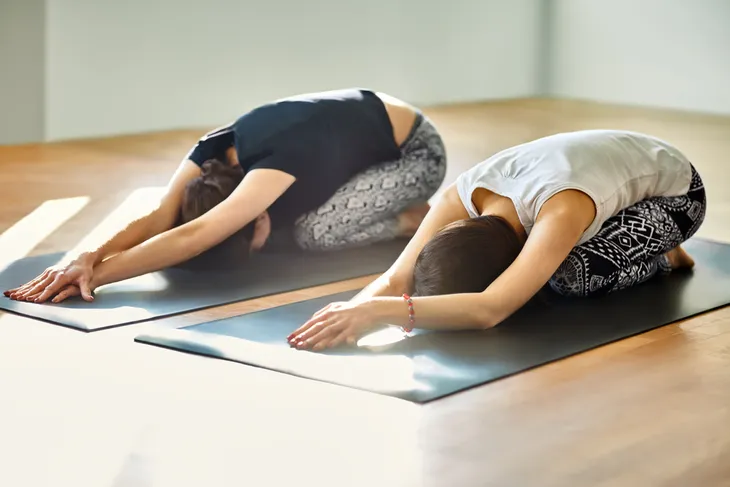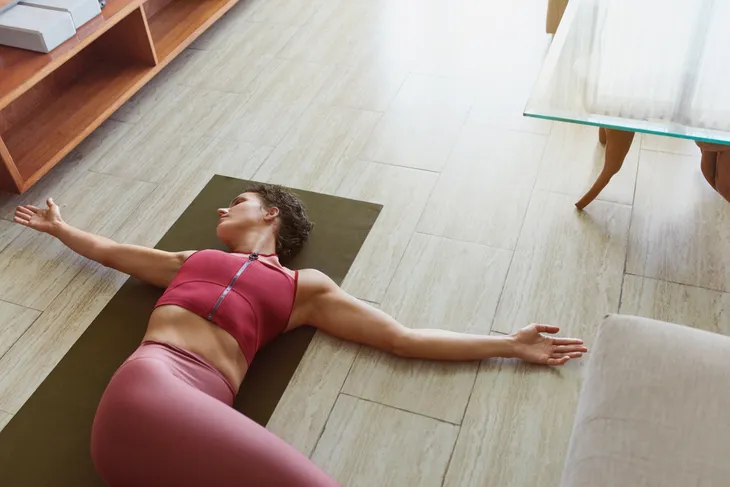- Releasing tension in your muscles by stretching can help to promote a high-quality, deeper sleep.
- It’s important to have healthy habits and a nighttime routine that can signal to your body that it’s time to rest.
- Some simple habits to promote sleep include optimizing sleep environment, avoiding electronics and exercising regularly.
Are you having trouble sleeping? It might be time to reevaluate some of your habits and create new routines to promote a restful night’s sleep. One area that’s often overlooked is the value of a stretching routine before bed. This simple act has been proven to improve quality of sleep and help you fall asleep quicker.
Stretching helps you take time out of your day to be mindful and get in touch with your body, but it also helps to loosen tight muscles and prevent cramps that may be disrupting your sleep. Follow along for some stretches and habits you should practice before bed to improve your sleep:
Stretch: Neck Stretch
We hold a lot of tension in our neck, shoulders and upper back from daily stresses. It’s important to relieve stress in this area with stretches, which can help to promote sleep and improve your posture.
One popular neck stretch is to gently tilt your head sideways and bring your right ear towards your right shoulder. Hold this position for five breaths, then repeat on the opposite side. Another neck stretch you could try is dropping your chin forward down to your chest. Hold for five seconds, return to a neutral position, and repeat.
 Shutterstock/9nong
Shutterstock/9nongStretch: Forward Fold
A forward fold is an easy pose to do in bed and helps to release tension in the spine, shoulders, lower back and hamstrings.
To do this stretch simply sit with your legs straight in front of you. Lengthen your spine and hinge at the hip to fold forward. Relax your head and reach your arms as far in front of you as you feel comfortable. Hold pose for up to five minutes for maximum benefit.
 Shutterstock/Undrey
Shutterstock/UndreyStretch: Cat-Cow
The lower back is a common area for tightness and pain with all the sitting, standing and walking we do on a daily basis. A great way to stretch your lower back and entire spine is doing the cat-cow stretch.
To perform this stretch, you will begin on your hands and knees with your hands directly below your shoulder and knees directly below the hip. Arch your back and point your chin towards your chest, then switch to letting your lower body sag and stretching your neck towards the ceiling. Hold each position for 10 seconds and repeat five to ten times.
 Shutterstock/solar22
Shutterstock/solar22Stretch: Child’s Pose
Child’s pose is a great basic stretch that you can do before sleep to promote relaxation. The stretch helps to relieve tension in the lower back and stretches the glutes and upper body. It also helps to realign the spine.
To perform this stretch, begin on your hands and knees. Slowly lower your body towards your feet and keep your arms reached in front of you. Hold for 30 seconds and repeat three to five-times.
 Shutterstock/Viktor Gladkov
Shutterstock/Viktor GladkovStretch: Hip Opener Stretch
If you tend to hold tension in your hips, this hip opener stretch could be helpful to try. This stretch helps to relieve tension in your hips and groin and is the perfect stretch if you work in an office or spend most of your day sitting.
To begin this stretch, simply lay on your back and bring the soles of your feet together. Place your arms in a comfortable position and focus on letting the hips and thighs relax outwards. You can hold for up to 10-minutes or longer for maximum release.
 Shutterstock/Space_Cat
Shutterstock/Space_CatStretch: Supine Twist
Gentle twisting has so many benefits for the body and can help to promote relaxation before bed. The supine twist stretch is a great way to open the entire spine, but especially targets the thoracic spine and upper back.
To perform this stretch, lie on your back and bring your knees to your chest. Drop both knees to one side and twist your torso in the opposite direction. Ensure to try to keep your knees and hips in line with each other and your chest square to the ceiling. Hold for 30-seconds then repeat on the other side.
 Shutterstock/puhhha
Shutterstock/puhhhaStretch: Legs Up The Wall
If you’re looking for a low impact, restorative pose, it might be beneficial to try the legs up the wall stretch. This gentle stretch helps to reduce tensions in the back, shoulders and neck while also promoting relaxation, circulation and lymphatic drainage.
To perform this stretch, begin by simply lying on your back in bed or on the floor with your legs against the wall. Be sure to try to get your hips as close to the wall as possible for maximum benefit. Hold for five to ten-minutes.
 Shutterstock/mariakray
Shutterstock/mariakrayHabit: Be Consistent With Your Schedule
Aside from stretches, there are also some habits you could begin to practice to encourage a restful night’s sleep. One of the best strategies is to be consistent with your sleep schedule. Try to plan a time that you go to sleep every night and a time that you wake up in the morning.
According to Healthline, this helps your body’s circadian rhythm function effectively by being set on a loop. Being consistent with your sleep schedule can promote long term, high-quality sleep.
 Shutterstock/Andrey_Popov
Shutterstock/Andrey_PopovHabit: Exercise Regularly
Another effective habit to help promote deep, high-quality sleep is having a regular exercise routine. This can help enhance many aspects of your life but is proven to improve sleep and reduce symptoms of insomnia. Exercise can help you get deeper sleeps and also help you fall asleep faster.
One factor to be aware of is to be sure to avoid exercising too close to when you go to sleep because it tends to increase alertness and energy levels.
 Source: Shutterstock
Source: ShutterstockHabit: Avoid Electronics Before Bed
Blue light, which is emitted from electronic devices such as televisions and smartphones, can trick your body into thinking its daytime, which can lead to a poor quality sleep or an inability to fall asleep.
If you’re struggling with sleep, it could be beneficial to avoid devices in the evening or for at least for an hour or two before you plan to sleep. You could also purchase blue light glasses which can block or absorb blue light to reduce your exposure.
Habit: Optimize Bedroom Environment
Your bedroom environment is key to promoting a good night’s rest. A few factors to be aware of include temperature, noise, and external lights. Try to make your bedroom a place that you can truly unwind and relax by minimizing any external light or noise. You could invest in a white noise machine or blackout blinds to ensure your environment is optimized for sleep.
In terms of temperature, the Sleep Foundation has shared that most doctors recommend keeping your thermostat between 60 to 67-degrees Fahrenheit (15.6 to 19.4-degrees Celsius) for the most comfortable sleep.
 Shutterstock/Gorodenkoff
Shutterstock/GorodenkoffHabit: Focus On Relaxing Practices
Relaxing habits that wind your body down are an effective tactic to promoting a good night’s sleep. The type of relaxation routine can vary for everyone, but some common relaxing activities include reading a book, taking a hot bath or shower, meditating, listening to calming music, or practicing deep breathing.
Adding these pre-sleep practices into your routine can help promote a good night’s sleep. You can always try out different methods and routines to find what works best for you.
 Shutterstock/Dusan Petkovic
Shutterstock/Dusan Petkovic



